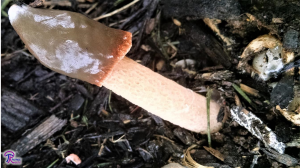#219: Coprinellus domesticus
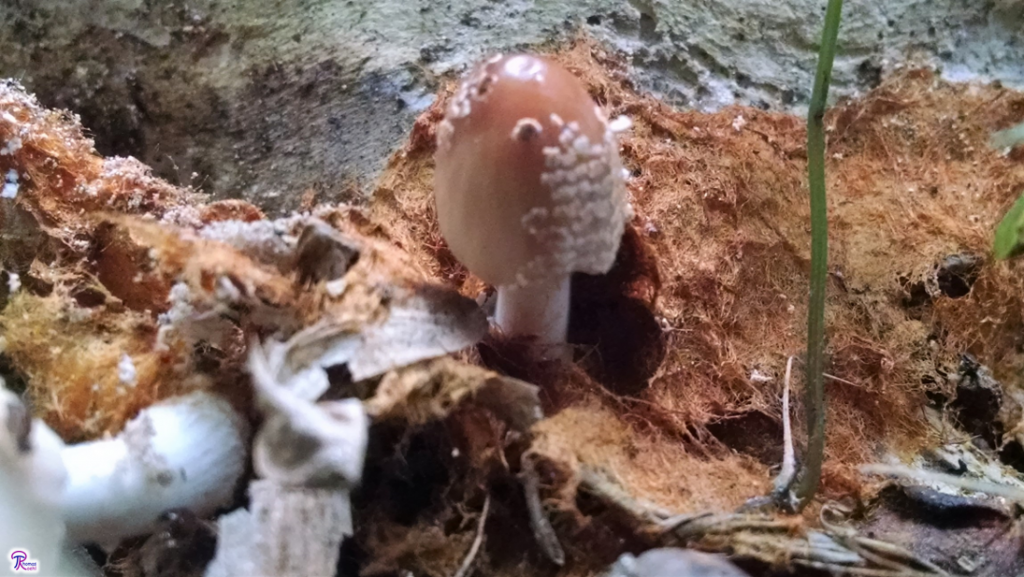
Coprinellus domesticus is a light brownish inkcap that usually produces a striking orange fuzz over its substrate. This fuzz makes identification easy; without the fuzz, it looks quite similar to many other inkcaps.
One of the most unusual things I found in my first year of mushroom hunting was a log covered with a layer of orange fuzz – reminiscent of shag carpeting, which looks out-of-place in a natural setting. After much searching, I discovered that the fuzz was produced by a mushroom: Coprinellus domesticus. The mushroom itself is an inky cap, but the fuzz – called an ozonium – lasts longer and is therefore easier to find. Nobody knows why the fungus makes an ozonium, but it certainly makes identification easier. You might also find this mushroom fruiting in your bathroom. As its species name implies, the fungus routinely appears in wet areas of homes. The mushroom has a few common names that are used occasionally. These include the “Firerug Inkcap” (primarily British), “Retro Inky” (from MushroomExpert.Com), and “Domestic Inkcap” (translated from French).1–4
Description
Like most inky caps, C. domesticus is an umbrella-shaped agaric with gills that deliquesce as the mushroom ages. The mushroom begins as an oval enclosed in a universal veil but the mushroom grows quickly to become the shape of a rolled-up umbrella. Eventually, the pileus opens and becomes convex to conical. Meanwhile, the gills turn black and liquefy from the edges in. When fully grown, the pileus gets up to 7cm across and the stipe gets 4-10cm long and up to 1cm wide.1–3
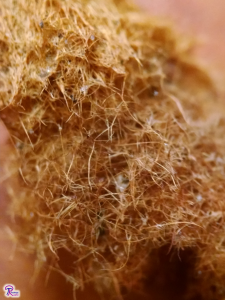
The ozonium is simply a tangle of hyphae growing on top of the fungus’ substrate. The purpose of the ozonium is not known.
When young, the cap is enclosed in a whitish universal veil. The veil breaks apart as the pileus expands, leaving small whitish to brownish warts on the cap surface. The warts are not attached to the pileus, so they easily brush off in wet weather or when touched. Underneath the veil, the pileus is light brownish-yellow and paler toward the edges. As it matures, the cap darkens to grey with a brownish center. Throughout development, the cap features radial furrows above where the gills are. These furrows or “striations” become more pronounced as the mushroom matures.1–3
Slice a young mushroom in half and you will find that the gills are white and are attached to the stipe or free from it. While the pileus expands, the gills darken to grey and eventually turn black and become inky.1–3
The stipe is white, smooth, hollow, and roughly even in width for its entire length, although it sometimes swells at the base. Part of the universal veil is sometimes left at the base of the stipe, forming a faint rim around the base.1,2
The most interesting part of the fungus surrounds the mushroom’s base. You usually (but don’t always) find the mushroom growing out of a mat of orange fibers called an ozonium.1–3 The ozonium is composed of sterile fungal hyphae and is really just an external mycelium. This structure is often more noticeable than the mushrooms thanks to its bright color. Mycologists don’t know why the fungus grows such an unusual structure; it doesn’t seem to serve any particular purpose.
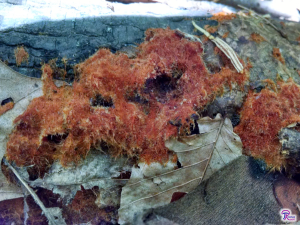
This is how you normally find C. domesticus: no mushrooms are visible, but the ozonium is still eye-catching.
Ecology
Usually, C. domesticus appears in small groups on hardwood logs, which it decomposes.1–3 However, the mushroom has also adapted to human environments. It can grow in woodchips, compost, and gardens.2 It is also one of the most common mushrooms that appears in wet indoor areas (such as bathroom rugs).1–3 The mushroom seems most likely to form an ozonium in its natural habitat – hardwood logs. In nature, the mushroom appears in the summer and fall.1 C. domesticus has been documented in North America, Europe, and scattered temperate areas around the world.4,5 You can probably find this mushroom throughout much of the world.
Similar Species
Another species, Coprinellus radians, is identical to C. domesticus in almost every respect.1,2 C. domesticus and C. radians are the only two species to form an ozonium, so if you find the ozonium you know your mushroom is one of two species.6 The only difference between the two is spore size: the spores of C. radians grow 8.5-12µm long and 5.5-7µm wide while those of C. domesticus are smaller, growing only 6-10µm long and 3.5-5µm.1,2 These species are so similar that some authors consider them to be one and the same.2 For most people, differentiating between the two species is impractical – how many people actually have access to a microscope that can be used to measure spore size? If you find only the ozonium or you can’t or don’t have the time to examine the spores, just label the fungus “C. domesticus” or “C. domesticus species group” and be done with it.
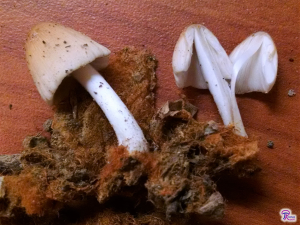
There are two species of mushrooms that form an ozonium: C. domesticus and C. radians. You can separate the two species only by comparing spore sizes. I did not do that for the mushrooms in these photos, so the pictured mushrooms could be C. radians.
There are a couple other species that appear similar when you ignore the fact that they lack an ozonium. Coprinellus flocculosus is the most similar – it differs only in having a more yellowish-brown cap and a less granular universal veil. Ecology is more helpful for distinguishing the species: C. flocculosus grows on woodchips, straw, sawdust, and other fine plant debris.7 Another potential point of confusion is Coprinellus micaceus (FFF#192). This species has distinctive universal veil remnants: the veil breaks up into small shiny mica-like granules. These are usually visible but sometimes wash off completely. C. micaceus also prefers to fruit in dense clusters from the bases of living or dead trees.2,7
Edibility
This species is considered “inedible” or “uninteresting.”2,3 Although it is not poisonous, its flavor and texture are not worthwhile and you never find enough of it to make a meal.
Taxonomy
The inky caps underwent a major taxonomic revision in the early 2000’s. Field guides written before 2001 listed this species as Coprinus domesticus.1 However, the genus Coprinus was found to be polyphyletic and was split up according to DNA work.6 C. domesticus was transferred to Coprinellus and placed in the family Psathyrellaceae.8 This family now contains all the inky caps except the Shaggy Mane (Coprinus comatus) and its relatives.6 See FFF#177 for more on inky cap taxonomy.
| Kingdom | Fungi |
| Subkingdom | Dikarya |
| Division (Phylum) | Basidiomycota |
| Subdivision (Subphylum) | Agaricomycotina |
| Class | Agaricomycetes |
| Subclass | Agaricomycetidae |
| Order | Agaricales |
| Family | Psathyrellaceae |
| Genus | Coprinellus |
| Species | Coprinellus domesticus (Bolton) Vilgalys, Hopple & Jacq. Johnson8 |
This post is not part of a key and therefore does not contain enough information to positively identify any mushroom. When collecting for the table, always use a local field guide to identify your mushrooms down to species. If you need a quality, free field guide to North American mushrooms, I recommend Michael Kuo’s MushroomExpert.com. Remember: when in doubt, throw it out!
Citations
- Kuo, M. Coprinellus domesticus: The Retro Inky. MushroomExpert.Com (2008). Available at: http://www.mushroomexpert.com/coprinellus_domesticus.html. (Accessed: 19th July 2018)
- Labbé, R. Coprinellus domesticus / Coprin domestique. (2014). Available at: https://www.mycoquebec.org. (Accessed: 19th July 2018)
- Péan, R., Péan, G., Mombert, A. & Bouet, C. Coprinellus domesticus(Bolton) Vilgalys, Hopple & Jacq. Johnson (2001). MycoDB (2017). Available at: http://www.mycodb.fr/fiche.php?genre=Coprinellus&espece=domesticus. (Accessed: 19th July 2018)
- Firerug Inkcap (Coprinellus domesticus). iNaturalist.org Available at: https://www.inaturalist.org/taxa/203062-Coprinellus-domesticus. (Accessed: 20th July 2018)
- Occurrence Map for Coprinellus domesticus (Bolton) Vilgalys, Hopple & Johnson. Mushroom Observer Available at: https://mushroomobserver.org/name/map/5096. (Accessed: 19th July 2018)
- Kuo, M. Coprinoid Mushrooms: The Inky Caps. MushroomExpert.Com (2008). Available at: http://www.mushroomexpert.com/coprinoid.html. (Accessed: 19th July 2018)
- Wood, M. & Stevens, F. California Fungi—Coprinellus flocculosus. The Fungi of California Available at: http://www.mykoweb.com/CAF/species/Coprinellus_flocculosus.html. (Accessed: 19th July 2018)
- Coprinellus domesticus. Mycobank Available at: http://www.mycobank.org/name/Coprinellus%20domesticus&Lang=Eng. (Accessed: 19th July 2018)

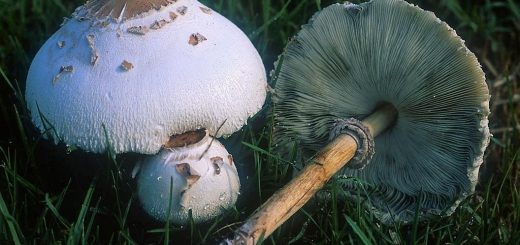
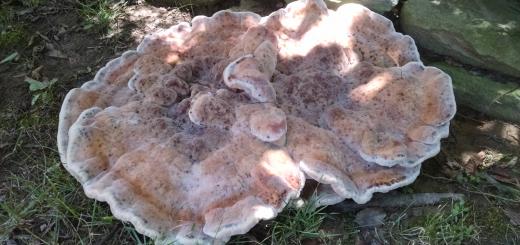






![#011: Characteristics of Kingdom Fungi [Archived]](https://www.fungusfactfriday.com/wp-content/themes/hueman/assets/front/img/thumb-small-empty.png)

